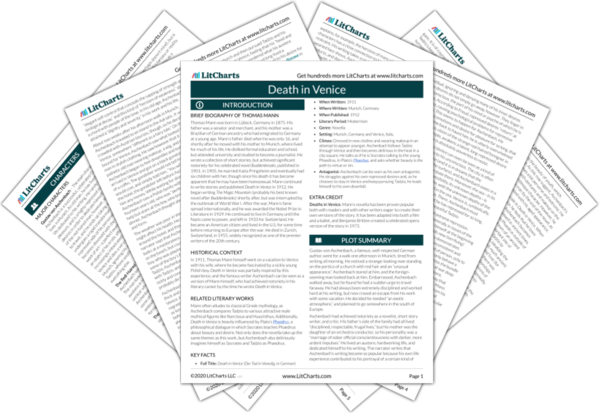Summary
Analysis
On an afternoon in May, in an unspecified year early in the 1900s, Gustav von Aschenbach, a well-regarded writer in Germany, went for a walk in Munich. He had spent the morning hard at work writing with “extreme circumspection, discretion, forcefulness and exactitude of the will. Tired, he hoped some fresh air would “restore him and help him have a profitable evening.”
It was unseasonably warm outside and after Aschenbach had walked for a while, he saw that a storm was approaching. He waited for a streetcar to bring him back home, and looked at a nearby Byzantine-style church. He was reading the various inscriptions on the church, when he suddenly noticed a man on the church’s porch with red hair and a “somewhat unusual appearance.”
The unseasonably warm weather perhaps foreshadows the uncharacteristic passion (an intense, latent desire for exotic travel) that will soon come over Aschenbach.
Themes
The strange man appeared to be foreign and “peered sharply and searchingly into the distance with colorless, red-lashed eyes.” Aschenbach couldn’t help but stare and soon found that the stranger was looking right back at him. He became embarrassed and walked away, but now felt stirring within himself “a youthfully ardent desire for faraway places. . . an urge to travel.”
This was no ordinary desire, though. It was like “a real seizure,” or “a delusion of the senses.” In his mind, Aschenbach imagined a lush tropical landscape with “lusty fern clusters,” and exotic plants and animals. Finally, he saw the eyes of a crouching tiger in some bamboo. His sudden vision completed, Aschenbach continued walking.
Aschenbach’s vision of a beautiful, sensuously described destination can be seen as symbolic of his desire to get in touch with his inner desires and urges. The tiger suggests that such a “visit” to the more primal parts of his self may be dangerous.
Themes
Get the entire Death in Venice LitChart as a printable PDF.

Up until this point, Aschenbach had never “been tempted to leave Europe,” because of his desire to work at writing and his “European spirit.” Now, somewhat late in his life, as he worried that he might die before he had a chance to finish his work, he had confined himself mostly to Munich. Thus, he quickly restrained his urge to travel with “the self-discipline he had practiced from his youth.”
Aschenbach did not want to waste time vacationing when he was working on “the book he was now living for.” However, he also craved some kind of escape from his work. He had been feeling dissatisfied with his writing. He had always “curbed and chilled his emotions,” and now feared that they were “taking their toll by abandoning him, by refusing to further his art and lend it wings.”
After much internal debate, Aschenbach finally concluded that he needed some travel, “an exotic atmosphere.” He decided to spend “a siesta of three or four weeks at some well-known holiday resort in the charming south of Europe.” He resolved to look at “maps and timetables” that night to plan his trip. As he finally got on the streetcar to take him back home, he looked around for the red-headed stranger but could find him nowhere.
Aschenbach’s repressed desire now overcomes him. His decision to travel south can be seen symbolically as a plan to “travel” also to his unconscious and to other parts of his own psyche. At this point in the story, though, Aschenbach is still rational and disciplined, as shown when he meticulously examines timetables to plan his trip.
Themes












